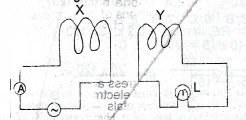(a)(i) What is an eclipse?
(ii) List the three types of eclipse.
(b) A student in a lecture theatre can read from the board clearly but requires a pair of spectacles to read from a book.
(i) What eye defect has this student?
(ii) What type of lens is needed to correct the eye defect?
(iii) The focal length of the lens used to correct this defect is 10cm. Calculate the power of the lens.
(c) A car B moves towards a stationary car A. If B produces an ultrasonic sound at a point and it takes 5.6 x 10\(^{-3}\)s for a beep to be heard in B, calculate the distance between the two cars at that instant. (Speed. sound in air = 340 ms\(^-\))
(d) The image of an object is located 9 cm behind a convex mirror. If magnification produced is 0.6, calculate the focal length of the mirror.
(a) Explain mutual induction
(b) State four use of electromagnets

The diagram above illustrates two coils X an arranged so that their axes are collinear. X is connected to an a.c. supply and has an amme in series with it while Y is connected to a lamp Explain the following observations. The (i) lamp is lit when the a.c. supply is switched on;
(ii) brightness of the light from the lamp increases when distance between X. and Y is decreased;
(iii) filament of the lamp glows brighter whet bundle of insulatttriron wires is placed along ccmmon axis of the coils.
(d) Two cells, one have an emf of 2.0 V and an internal resistance of 0.4 and the other having an emf of 2.0 V and an internal resistance of 0.1 \(\Omega\), are connected in parallel. The combination is then connected in series with a resistor.
(i) Draw a circuit diagram of the arrangement.
(ii) Calculate the current through 5\(\Omega\) resistor.
(a) Explain the terms:
(i) transmutation as it relates to radioactivity; (ii) stopping potential.
(b) \(^{23}_{11}A + ^2_1B\) —> \(^p_qC\) + proton
\(^p_qC\) —> \(^r_sE\) + beta
A nucleus C, formed artificially from A and B radioactive and quickly decays to another nucli E as indicated in the nuclear equations abc Datermine the values of p, q, r and s.
(c) A certain metal of work function 1.6 eV is irradiated with ultra-violet light of wavelength 3.6 x 10\(^{-7}\) Calculate the maximum
(i) kinetic energy of ejected electron in joules;
(ii) speed of an emitted electron. (1eV = 1.6 x 10\(^{-18}\) J; C = 3.0 x 10\(^{8}\) ms\(^{-1}\); m, = 9.1 x 10\(^{-31}\) kg; h = 6.6 x 10\(^{-34}\) Js)
(d) If source of the ultra-violet light in (c) above is mo away from the surface of the metal, state the of on the maximum speed of the ejected electron
State three properties of cathode rays which suggest the particle nature of matter

You are provided with a wooden block to which a hook is fixed, a set of masses, spring balance, and other necessary materials. Using the diagram above as a guide, carry out the following instructions.
(b)i. Define coefficient of static friction.
ii. A block of wood of mass 0.5 kg is pulled horizontally on a table by a force of 2.5 N. Calculate the coefficient of static friction between the two surfaces.(g = 10ms\(^{-2}\))